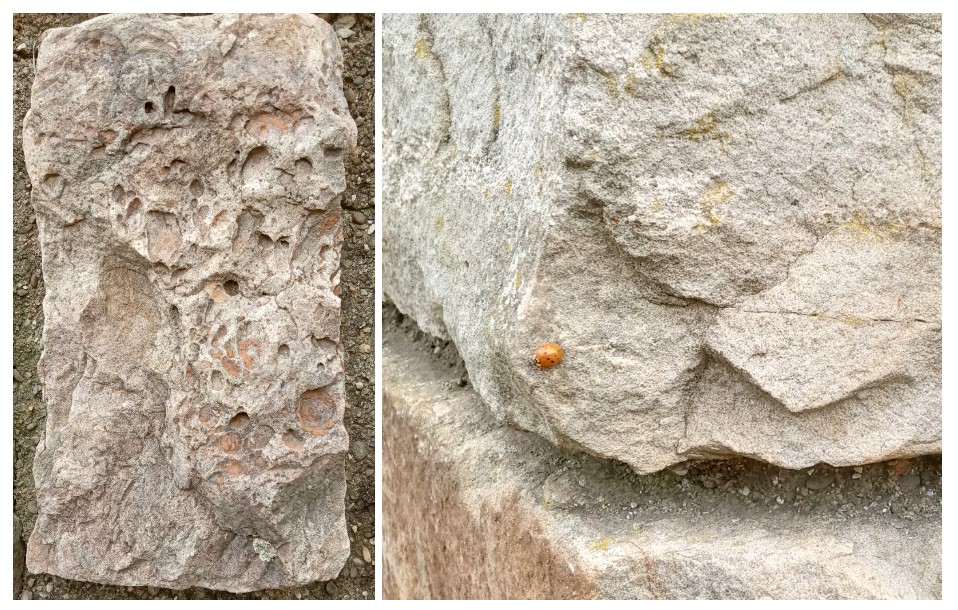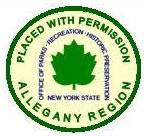Allegany State Park – Stone Tower
NOTE … A permit is required to place this cache in Allegany State Park. Call to get the form.
Coordinates … N 42° 07.747 W 078° 42.790 / Parking N 42° 07.790 W 078° 43.150

EARTHCACHE REQUIREMENTS
Each cacher must send his/her own answers to log a find. … “Geocachers must complete the tasks before they log the EarthCache as found.” (4.3. EarthCache logging tasks)
Enjoy the journey (learning adventure) as well as the destination (smiley earned). Remember to take only pictures and leave only footprints. To get credit for this Earthcache, complete the following tasks:
NOTE: Posted coordinates are for Stone Tower Road. Unable to place EC coords at the tower due to cache proximity.
NOTE: All observations are done around the outside of Stone Tower to make this earthcache accessible to everyone.
NOTE: Answers via message -and- log signature picture are required to post a find for this cache.
1. MESSAGE / NORTH …. Observe this side of the tower. Give one example of weathering -and- explain how it changed the appearance of the rocks. Different answers for each side of the Stone Tower.
2. MESSAGE / EAST …. Observe this side of the tower. Give one example of weathering -and- explain how it changed the appearance of the rocks. Different answers for each side of the Stone Tower.
3. MESSAGE / SOUTH …. Observe this side of the tower. Give one example of weathering -and- explain how it changed the appearance of the rocks. Different answers for each side of the Stone Tower.
4. MESSAGE / WEST …. Observe this side of the tower. Give one example of weathering -and- explain how it changed the appearance of the rocks. Different answers for each side of the Stone Tower.
5. MESSAGE … As you observe each side of the tower, is there a noticeable difference in the weathering. What do you think is causing these differences? Perhaps prevailing weather patterns preferentially expose sides of the tower to more moisture than the others resulting in increased mechanical/chemical weathering. Or maybe differing sunlight exposure causes different surface temperatures leading to different rates of biological weathering.
6. MESSAGE …. Several years ago the Stone Tower was cleaned with all grafitti removed. Compare what you see at the time of your visit with the picture on this cache page.
7. LOG … Post a picture of you or your signature item with your favorite stone -and- explain why you chose it. This picture is your log signature.
I chose these two rocks because it looks like my shelties left their prints here -and- we watched this critter meandering along with colors that matched the rock.

ADVICE FROM A LADYBUG … Spot new opportunities. / Spend time in your garden.
Be well-rounded. / Enjoy the wonders of nature. / Don’t let the small things bug you.
Keep family close by. / Be simply beautiful!
OPTIONAL – Please respect the time and effort involved in finding and creating this earthcache by adding A and B to your log.
A. JOURNEY OF THE MIND … Science explains what we observe. Relate (in your own words) something you found interesting in the reading. This adds to your learning adventure and your log.
B. JOURNEY OF THE HEART … Art shares our personal experience of what we see. Share something special you found on site, and why it is special to you … prose / story / poem / picture. This is a memorable addition to your log and will make other hearts smile.
Journeys of Heart and Mind …
Stories to Touch the Heart and Puzzles to Challenge the Mind / Rainbow Tree Story
THANK YOU Allegany State Park for permission to share this learning adventure.

STONE TOWER
The construction of Stone Tower begin in October of 1933 and was completed in the spring of 1934. The stone used to build the tower was all collected and cut in Allegany State Park. The octagonal shaped tower stands at an elevation of 2,250 feet and overlooks Salamanca to the North and Red House Lake to the South. A capital “N” was carved in the center of the upper deck with an arrow through it to indicate which way is North.
WEATHERING
Weathering is the breaking down of rock into smaller fragments. All rock weathers over time. Grains of sediment fall out. Cracks develop on the surface and deep inside. Weathering causes rocks to fracture, buckle, and crumble into soil and sediment. There are two types of weathering – mechanical and chemical.
MECHANICAL WEATHERING
Mechanical Weathering breaks apart rocks without changing their chemical composition. Each fragment and particle weathered away by a mechanical process retains the same characteristics as the original rock. Mechanical weathering can be caused by growing plants, expanding ice, lightning, and expansion and contraction with heating and cooling. These physical processes create enough force to break rocks into smaller pieces.
CHEMICAL WEATHERING
Chemical Weathering occurs when water, air, and other substances react with the minerals in rock. In chemical weathering, the composition of the rock changes.
BIOLOGICAL WEATHERING (Mechanical/Chemical)
Living organisms contribute to mechanical weathering through the growth of roots or the burrowing of animals. Tree roots grow into cracks and joints, increasing the surface area for continual weathering by plants, wind, and water. Plants give off organic acids as part of their life and decay processes. These acids help to break down rocks chemically. Decaying remains of dead animals in soil may form organic acids which, when dissolved in water, cause chemical weathering.
VASCULAR PLANTS (larger and grow out from the rocks) – Plant roots and seedlings sprouting in a crevice exert physical pressure as well as providing a pathway for water and chemical infiltration. The evidence that some soil is present is found in the plants which appear to be growing “out” of the rock. In reality, these plants have roots that are growing in soil that is located in the cracks of the rock.
NONVASCULAR PLANTS (smaller and cover surface of rocks) – Lichens and mosses grow on essentially bare rock surfaces and create a more humid chemical microenvironment. The attachment of these organisms to the rock surface enhances physical as well as chemical breakdown of the surface microlayer of the rock.
ANIMALS – Burrowing animals and insects disturb the soil layer adjacent to the bedrock surface thus further increasing water and acid infiltration and exposure to oxidation processes.
ORGANICS – Rocks are often covered with lichen and other organics, which sometimes appear like inclusions.
RESOURCES
Kiosk at the Stone Tower
Earth Mother’s Paintbrush
MY ANSWERS
- NORTH … Biological Weathering. There are vascular plants growing in the cracks, mostly at the top and the bottom.
- EAST … Chemical Weathering. This side is almost completely covered with black, possibly caused by environmental pollutants.
- SOUTH … Biological Weathering. There are non-vascular plants (moss) growing on the surface of about 20% of the rocks.
- WEST … Mechanical Weathering. There are pits caused by water and wind abrasion.
- There is some graffiti on the current stones. It is minimal occurring on less than 1% of the stone blocks. On the east side there is a lot more black covering the stones. There is also a significant amount of vegetation on all sides.
REVIEWER NOTES
Thank you for your EarthCache submission. A few adjustments are required to bring the EarthCache into compliance with the EarthCache guidelines posted at http://www.geosociety.org/GSA/fieldexp/EarthCache/guidelines/home.aspx. Additional information may be found in the Groundspeak Knowledge Books at https://www.geocaching.com/help/index.php?pg=kb.chapter&id=51.
- Perhaps as interesting as the fact that each side of the tower exhibits a different type of weather, the WHY this is the case would complete the Earth Science lesson.
- Because EarthCaches do not have a physical cache associated with them, the coordinates of the EarthCache can be (and are recommended to be) at the tower.
I may have been confused by the phrase “different answers for each side of the Stone Tower,” meaning each side of the Stone Tower has an example of different weathering. It appears from the logging task answers that both the north and south sides of the tower are subjected to biological weathering. What I was getting at regarding “WHY” is perhaps prevailing weather patterns would preferentially expose one or more sides of the tower to more moisture than the others, that differing sunlight exposure would lead to different surface temperatures that would lead to different rates of biological or mechanical or other weathering.